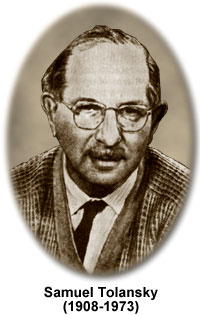Samuel Tolansky
(1907-1973)

Born in Newcastle upon Tyne, England as Samuel Turlausky, Tolansky was educated at Rutherford College from 1919-1925, followed by three years of study at Durham University. In 1929, he graduated with a degree in the Theory and Practice of Teaching and became a Fellow of King's College. The Earl Grey fellowship that Tolansky received in 1931 enabled him to travel to Berlin. On his return, he was awarded the 1851 Exhibition Senior Studentship at Imperial College, London, and studied for two more years before taking on the role of Physics lecturer at Manchester University.
During his time at Manchester, Tolansky performed a significant amount of his research and developed the interference contrast microscopy technique that bears his name. Using the Airy formula for multiple reflection between parallel plane surfaces as a starting point, Tolansky carefully investigated the intensity distribution of fringes that appear as a result of multiple-beam interference. From his work, he was able to determine a mechanism to sharpen the fringes and, consequently, defined the conditions necessary for attaining the greatest precision in detecting changes in surface height. In Tolanksy's technique the surface of the reference plate and the specimen are coated with a highly reflective film. The reflective surfaces of the microscope are situated so that the distance between them is as minute as possible, and incident light beam is collimated to a parallelism within 3 degrees and made nearly perpendicular to the reference plate.
Other research interests of Tolansky included the analysis of spectra to investigate nuclear spin and the study of optical illusions. Although he was primarily concerned with the spectrum of mercury, during World War II Tolansky was asked to ascertain the spin of uranium-235, the isotope capable of fission in a nuclear chain reaction. Even though he only had samples with a proportion of approximately 0.7 percent to work with, he was quite successful. Tolansky's explorations of the mind's misapprehensions of certain optical phenomena was also fruitful, resulting in the book Optical Illusions, published in 1964.
In 1948 Tolansky became Professor of Physics at the Royal Holloway College, University of London, a post he held until his death in 1973. He was awarded many awards throughout his lifetime, including the C.V. Boys Prize from the London Physical Society for his contributions to optics. Tolansky also participated in numerous scientific groups, such as the Royal Scientific Association, the Scientific Advisory Committee, the Royal Microscopical Society, and the American Association for the Advancement of Science. During his later years, Tolansky was part of the NASA Lunar Project and was one of the principal investigators of the moon rocks and dust brought to earth from the Apollo flights. A large crater located nearby the Apollo 14 landing site was named in his honor.
